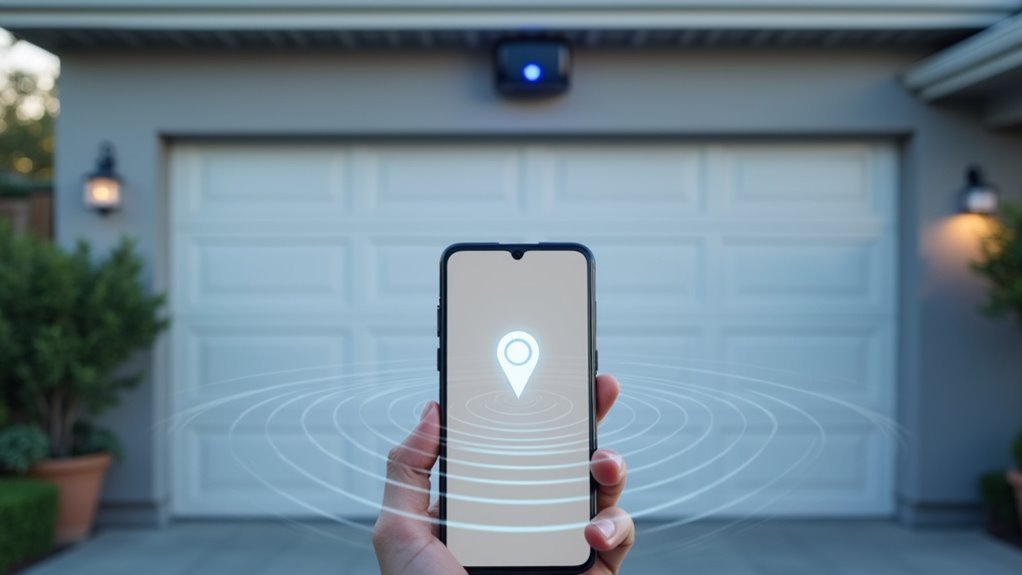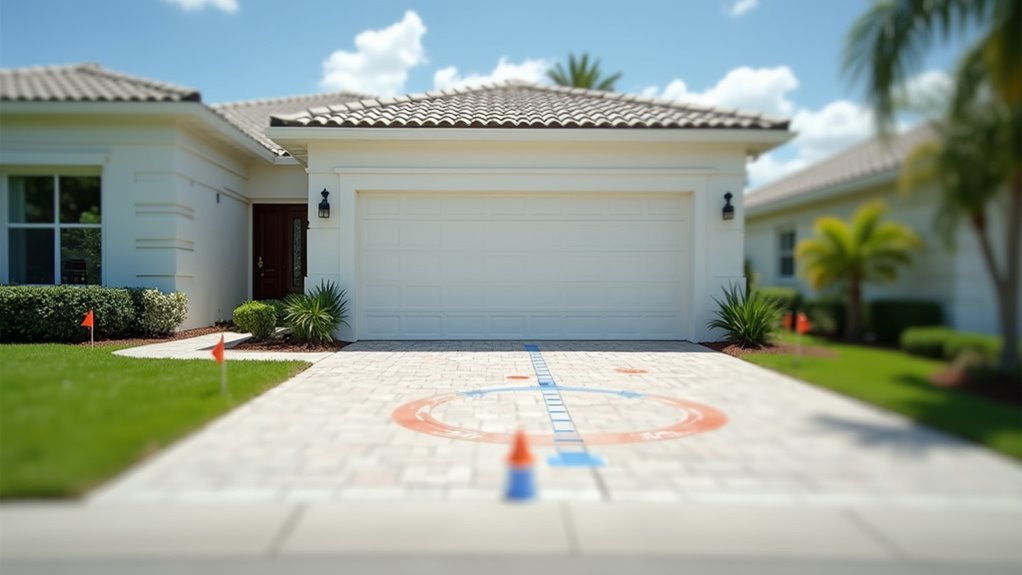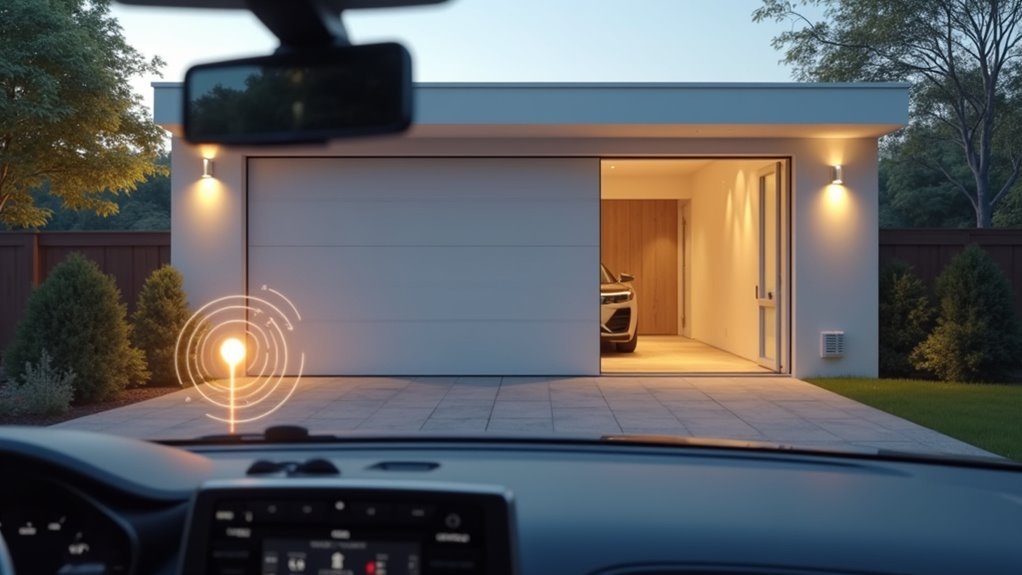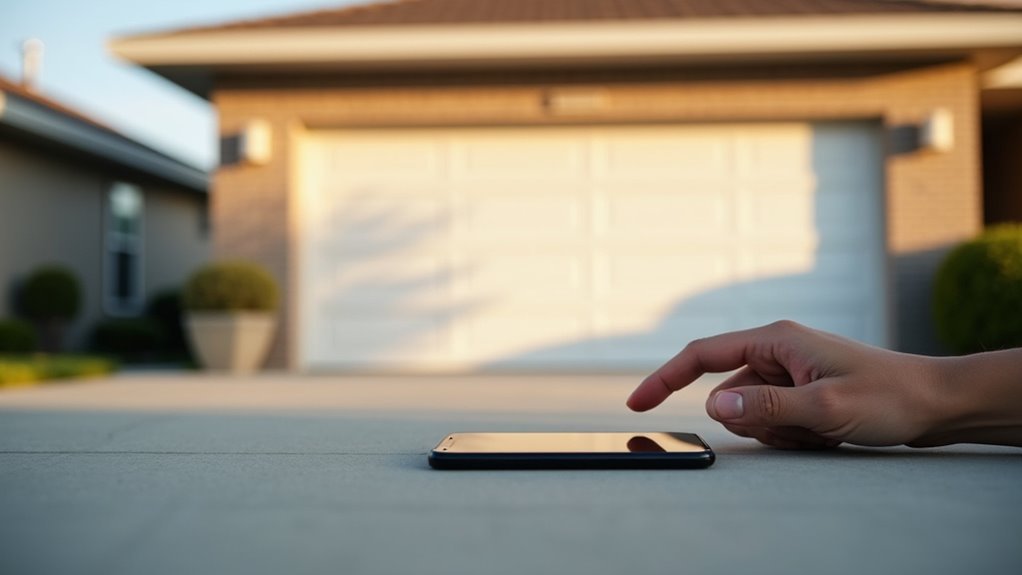You’ve probably experienced the frustration of arriving home only to realize your garage door opener isn’t responding as expected. Geofencing technology promises to solve this by automatically triggering your garage door when you’re nearby, but improper setup can lead to doors opening unexpectedly or failing to respond when needed. The difference between a seamless smart home experience and a security nightmare often comes down to how well you’ve configured these seven critical settings.
Configure Location Accuracy Settings for Optimal Performance

When setting up geofencing for your garage door opener, you’ll need to enable GPS, Wi-Fi, and cellular data on your device since these technologies work together to create precise virtual boundaries.
Access your smart garage door opener’s companion app and adjust the geolocation settings to allow more frequent location updates. This enhances tracking reliability and guarantees your garage door responds accurately to your movements.
Frequent location updates in your garage door app ensure reliable tracking and accurate response to your movements.
Navigate to your device’s privacy settings and grant the app permission to access your location at all times.
Configure the app to use high-accuracy mode, which utilizes all available positioning services.
Don’t forget to disable battery optimization for the garage door app, as power-saving features can interfere with consistent location monitoring and reduce geofencing effectiveness.
Set Appropriate Geofence Boundary Distances
How close should you position your geofence boundary to achieve reliable garage door automation? Finding the right distance is essential for effective geofencing with your garage door opener.
Set the boundary too close, and you’ll experience frequent false triggers. Position it too far, and you’ll face delays in opening or closing your garage door.
The ideal geofence radius typically ranges between 100 to 300 feet. This distance provides timely activation without unnecessary triggers.
Consider your property’s layout when determining the boundary, ensuring it covers areas where you normally approach or leave in your vehicle.
After setup, test the geofence distance to fine-tune the radius based on your driving habits.
Regularly review and adjust settings to accommodate routine changes or environmental factors around your home.
Test Multiple Entry and Exit Points Around Your Property

Why test just one approach route when your property likely has multiple access points?
You’ll discover that different entry points have varying signal strengths that can affect your geofencing performance. Test your garage door opener from various angles and distances around your property perimeter to identify ideal activation zones.
Map out a virtual boundary that accounts for potential obstructions like trees, buildings, or terrain that might interfere with GPS or Wi-Fi signals.
Each approach route requires individual testing to guarantee your smart home automation responds accurately without false triggers or missed openings.
Regular testing of multiple entry and exit points helps you refine the geofencing area for seamless operation, providing reliable convenience and enhanced security based on your precise location.
Adjust Sensitivity to Prevent False Triggers
After identifying your ideal geofencing zones through thorough testing, you’ll need to fine-tune your garage door opener’s sensitivity settings to eliminate unwanted activations.
Smart garage door openers let you adjust the geofencing distance to prevent doors from opening when you’re simply passing by your property. Lower sensitivity reduces false triggers from nearby vehicles or pedestrians walking within your configured area.
Test your adjusted settings by simulating realistic entry and exit scenarios around your property. Walk or drive through different approaches to verify the door only responds when you genuinely intend to access your garage.
This balance between convenience and security prevents unauthorized openings while maintaining reliable operation.
Consult your opener’s manual for specific sensitivity adjustment procedures, as settings vary between manufacturers and models.
Integrate With Home Security Systems for Enhanced Protection

When you connect your smart garage door opener to your home security system, you’ll create a seamless network that automatically adjusts protection levels based on your location.
Geofencing integration allows your security system to arm or disarm automatically when you leave or return home, while contact sensors send real-time alerts if someone tampers with your garage door.
Smart geofencing technology transforms your garage door into an intelligent security hub that responds automatically to your movements.
You can program multiple automated actions through this geofencing setup. When leaving your designated area, the system automatically closes your garage door, locks other entry points, and activates monitoring modes.
Upon returning, it can disarm alarms and turn on lights for safe entry.
This home security integration creates customizable alerts matching your daily routines, ensuring thorough protection even when you forget basic security measures.
Create Backup Automation Rules for Reliability
Even the most reliable geofencing systems can experience connectivity hiccups or GPS delays that might leave your garage door vulnerable to security gaps.
That’s why implementing backup automation rules guarantees your smart garage opener remains functional when primary triggers fail.
Creating redundant systems protects against single points of failure in your geofencing setup.
Here’s how to build reliable backup automation:
- Combine multiple location signals – Use both GPS and Wi-Fi detection to create overlapping triggers that increase accuracy and reliability.
- Add time-based fail-safes – Program your garage door to automatically close after remaining open for a predetermined duration, regardless of geofencing status.
- Test and document regularly – Schedule monthly tests of your backup systems and maintain clear documentation for troubleshooting and household consistency.
This layered approach guarantees continuous protection.
Monitor Battery Usage and Optimize Device Settings
You’ll need to actively manage your smart garage door opener’s power consumption to prevent geofencing failures caused by dead batteries.
Start by adjusting location update frequencies and enabling energy-saving modes to strike the right balance between responsiveness and battery life.
Regular monitoring of your device’s performance metrics will help you identify power drain issues before they impact your garage door’s automated operation.
Battery Drain Prevention Methods
Smart garage door openers with geofencing capabilities can quickly drain their batteries if you don’t monitor and optimize their settings properly.
These smart devices require constant communication with your smartphone and home network, which can greatly impact battery life without proper management.
To prevent excessive battery drain, implement these essential strategies:
- Reduce location update frequency in your companion app settings to minimize power consumption while maintaining functionality.
- Disable unnecessary features like constant Wi-Fi connections, excessive notifications, or alerts that aren’t critical to your daily operations.
- Keep firmware updated since manufacturers regularly release updates that improve battery efficiency and overall device performance.
Consider installing a dedicated power source instead of relying solely on battery power to eliminate frequent replacement hassles.
Power Saving Configuration Options
Three primary configuration areas demand your attention when optimizing your smart garage door opener’s power consumption. You’ll need to adjust location update frequency, activate power saving modes, and disable unnecessary features through your companion app.
Start by reducing how often your device checks location—switching from continuous tracking to periodic updates markedly extends battery life. Next, enable power saving modes during inactive periods, which automatically reduces energy consumption when you’re not using the opener.
| Configuration Setting | Power Impact |
|---|---|
| Location Update Frequency | High |
| Power Saving Mode | Medium |
| Background Notifications | Medium |
| Firmware Updates | Low |
| Connectivity Features | High |
Finally, turn off features you don’t need, like constant notifications or background connectivity, as they drain battery unnecessarily while providing minimal value.
Performance Monitoring Best Practices
After implementing these power-saving configurations, monitoring your smart garage door opener’s actual performance becomes your next priority.
Regular battery levels checking guarantees you’ll avoid unexpected failures during critical moments when you need access most.
Effective performance monitoring requires systematic tracking of your device’s operational patterns:
- Check battery levels weekly through your companion app’s dashboard to identify potential power drain issues before they cause system failures.
- Adjust location update frequency in device settings to balance geofencing accuracy with energy consumption based on your usage patterns.
- Review automation trigger logs monthly to identify unnecessary activations that waste battery power and optimize your geofencing zones accordingly.
You’ll also want to monitor notification frequency and update firmware regularly, as manufacturers often release battery efficiency improvements that enhance overall device performance.
Frequently Asked Questions
How to Geofence Myq Garage Door Opener?
Download the MyQ app and create an account. Enable location services on your phone, define your geofence radius around home, set up notifications, and test the automation by entering and leaving the area.
How to Prevent Someone From Opening Your Garage Door?
Change your garage door’s default security codes regularly and install deadbolts for extra protection. Add security cameras around your garage area and consider upgrading to a smart opener with monitoring capabilities.
How Can I Make My Garage Door Remote Work Better?
Replace your remote’s batteries regularly and keep buttons clean from dirt buildup. Guarantee clear line of sight to the opener, position it away from interfering electronics, or upgrade to a smartphone-controlled smart opener.
Should I Get 1/2 Hp or 3/4 Hp Garage Door Opener?
You’ll want 3/4 HP if your door weighs over 300 pounds or sees heavy use. Choose 1/2 HP for lighter doors and occasional use. Consider future upgrades when deciding.





Leave a Reply